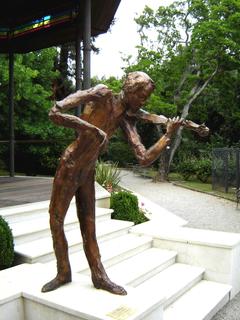Skulpture na javnim površinama
Ključna riječ vezana za skulpturu Tatjane Kostanjević ja pokret. Prisutan je u svakom radu. Kao dobar poznavatelj plesnih aksioma umjetnica ga ugrađuje u svako kiparsko razmišljanje, neovisno da li se radi o figurama plesačica, figurama koje predstavljaju zanos muziciranja ili legendama o natprirodnim silama gdje plesnu ulogu preuzimaju voda, vir, vjetar, valovi.
Pod tim se misli na urbane skulpture postavljene na javne površine.
Skulptura postavljena u čast velikoj reformatorici plesa Isadori Duncan postavljena u park u Opatiji, ne samo da svjedoči kako se plesačica inspirirala treptajem palmi na vjetru već svjedoči o prisutnosti glazbe.
Violinista također postavljen na ulazu Glazbenog paviljona u opatijskom parku gestom tijela i ruku prenosi zanos muziciranja.
Ples s maskama, brončana skulptura, dva metra visoka, postavljena u Novom Vinodolskom 1996. godine, kada je Hrvatska bila domaćin Evropske konvencije karnevalski gradova, predstavlja plesačicu ritualnog plesa koja jednom rukom potiskuje prema zemlji masku zla, a drugom uzdiže masku dobra.
Skulptura Sara - Babin Vir, četiri metra visoka, postavljena u Požegi, premda priča legendu iz doba Turaka, sadrži aksiome plesa gdje figura postaje napeta u svojoj uzlaznoj i istodobno silaznoj liniji. Pleše figura mlade djevojke jer plešu i vjetar i voda i vir. Figura je postala krilato biće koje lebdi između kuća u naselju Babin vir.
Sculptures in Public Spaces
The key word associated with the sculpture of Tatjana Kostanjevic is movement. It is present in her every work of art. The artist instills movement in her professional thinking about the scupture as a real expert in dance axioms, regardless of the fact that it is about dancers' figures, figures which represent the enthusiams of making music or about the legends of the supernatural forces where water, whirlpool, wind or waves take over the dance roles.
Sculptures in public spaces include all sculptures which were placed in urban areas.
One sculpture of the Dancer put up in the Central Park of the town of Opatija in honour of Isadora Duncan, who greatly influenced on dance techniques, is not only a witness to the inspiration the dancer had when contemplating the palms in the breeze but also a witness to the presence of music.
The next sculpture the Violinist put up at the entrance to the Music Pavillion in the Central Park in Opatija conveys the feelings of ecstasy whilst playing music through the whole body and arm movements.
The bronze sculpture The Dance with the Masks is 2 metres high, put up in the town of Novi Vinodolski in 1996 when Croatia was the host of the Convention of the Federation of European Carnival Cities. It represents a ritual dancer who with one hand demotes the mask of evil to the ground and with the other elevates the mask of good.
The sculpture Sara - Babin Vir, 4 metres high, was put up in the town of Pozega, even though it tells a legend from the times of the Turkish conquests, and contains dance axioms whereby the figure becomes tense in both its ascending and descending lines. A young lady figure dances because it represents the dance of wind, water and the whirlpool. The figure turned into a winged creature which floats among the houses in the village of Babin Vir.




















